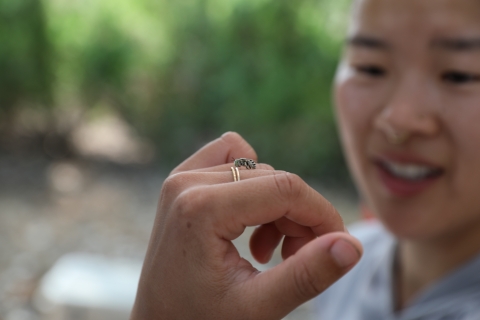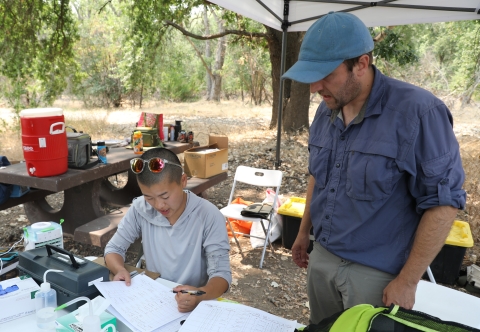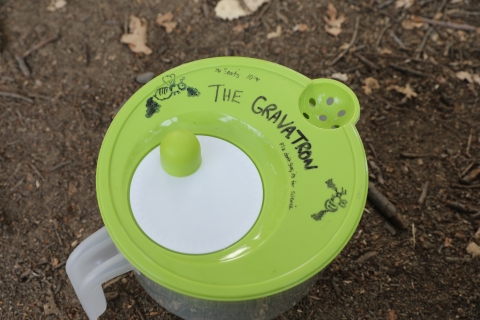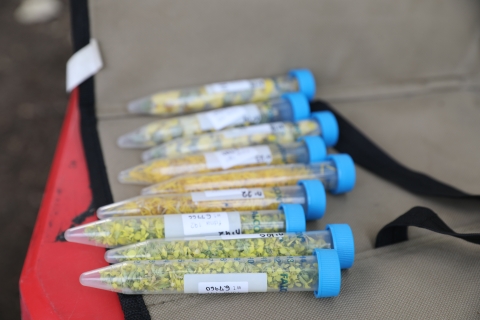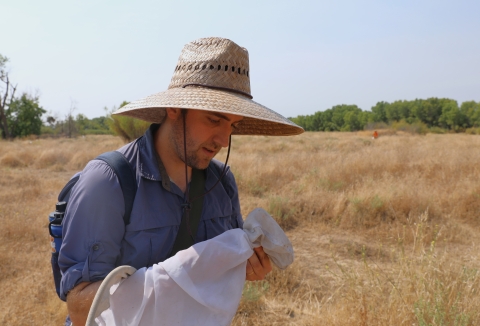Seeing native bees through the eyes of biologists will melt your heart.
“This one has the most beautiful blue eyes,” Nevin Cullen said of the leaf cutter bee he just netted. Cullen, a post doctoral researcher and pollination biologist with the USDA Agricultural Research Service, has a soft spot for Hymenoptera, the order (a taxonomic group) that includes bees, wasps, sawflies and ants.
During inaugural non-lethal bee surveys at Sacramento National Wildlife Refuge Complex, Cullen can be seen slowly crunching through dry grass, stalking unassuming bees and the occasional wasp, in attempt to capture the bee in his net.
The bees caught by Cullen and his team including U.S. Fish and Wildlife Service biologist, Therese Burns, are put in small tubes on ice, which effectively slows down their body and puts them into sleep-like state. The bees are then brought back to “home base”, photographed and sampled for their genetic material.
“Each bee species has a distinct personality,” Cullen said. “The Mason bees and leaf cutters like to sun themselves like pond turtles. The pebble bees are quirky and neurotic while bumblebees are curious and cautious.”
The bee biologists are not afraid to catch the bees or handle them. “Native bees will rarely sting you and the males, they don’t even have stingers,” Cullen explained. “They’re usually solitary creatures and they care more about surviving than they do about you. They’ll sting if severely threatened. Honeybees on the other hand, they’re part of a hive, and they will quickly sacrifice themselves for the sake of the colony.”
Cullen continues scouting for tiny moving objects in the grass before catching another bee. “This is a pretty one, the green metallic sweat bee. They have large speckled eyes too, like the leaf cutters,” he said.
Unfortunately, bee surveys have long been conducted through lethal means. It is challenging to identify some bee species visually, and genetic material is collected to determine species and composition of the native bees at a given survey site. As bee and pollinator populations decline across the globe, a group of experts recognized a need to investigate new survey methods and devised a plan to pilot non-lethal bee surveys at National Wildlife Refuges in northern California.
The surveys require humans to scout and catch the bees, insect nets, test tubes to hold the bees, coolers with ice, and a modified salad spinner.
Back at base, the bees are photographed and then have their DNA sampled.
“The salad spinner is like going on a carnival ride for these bees,” explained Burns. “The goal is to get them to vomit, shed hairs, or poop to collect their DNA. After the 60 second ride, we help the bees recover. Around 95% of the native bees fly away after about 30 seconds to 5 minutes, unbothered.”
This summer, 23 genera (plural of genus) were surveyed, based on the photographs taken at the time of genetic sampling and we expect to find more diversity when the DNA is sampled. This is consistent with the number of genera found in traditional lethal sampling, indicating that the non-lethal methods are performing and just as effective.
In conjunction with the bee sampling, Cullen and Burns collect flower tissue at the survey site. The flower tissue will also be analyzed for bee DNA to expand the genetic sampling at the site and learn which bees visit which flowers.
The non-lethal bee surveys will continue next year and will be evaluated annually for effectiveness and for potential expansion to other National Wildlife Refuges. This study was initiated and funded by the U.S. Fish and Wildlife Service and is part of a larger project to gain baseline information on butterfly and bees present on refuges in California and Nevada. The overarching project has three primary components: non-lethal butterfly surveys, non-lethal bee surveys and pesticide sampling via silicone bands and plant tissue. Partners include U.S. Geological Survey, University of Nevada – Reno, USDA Agricultural Research Service and Cornell University.


